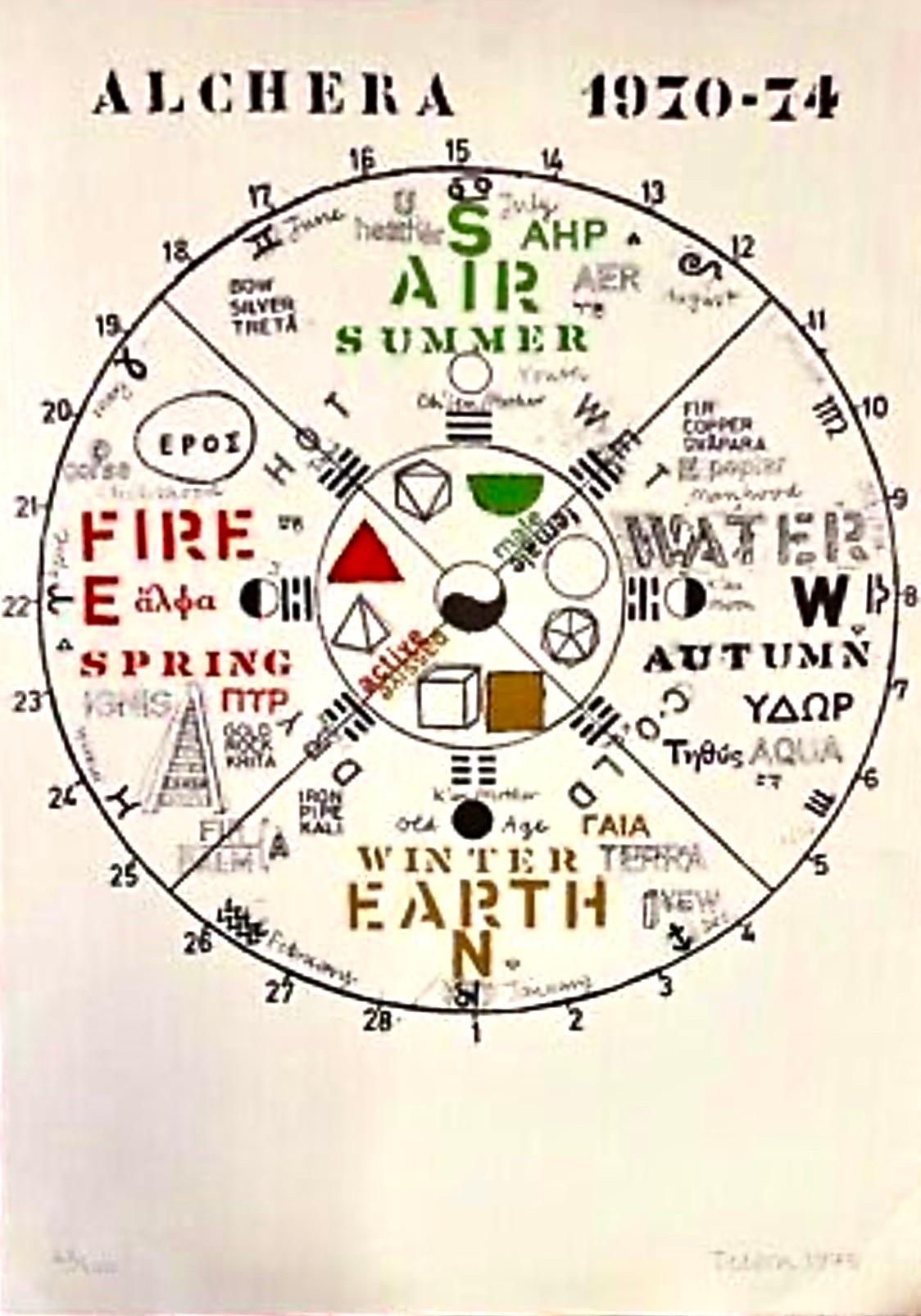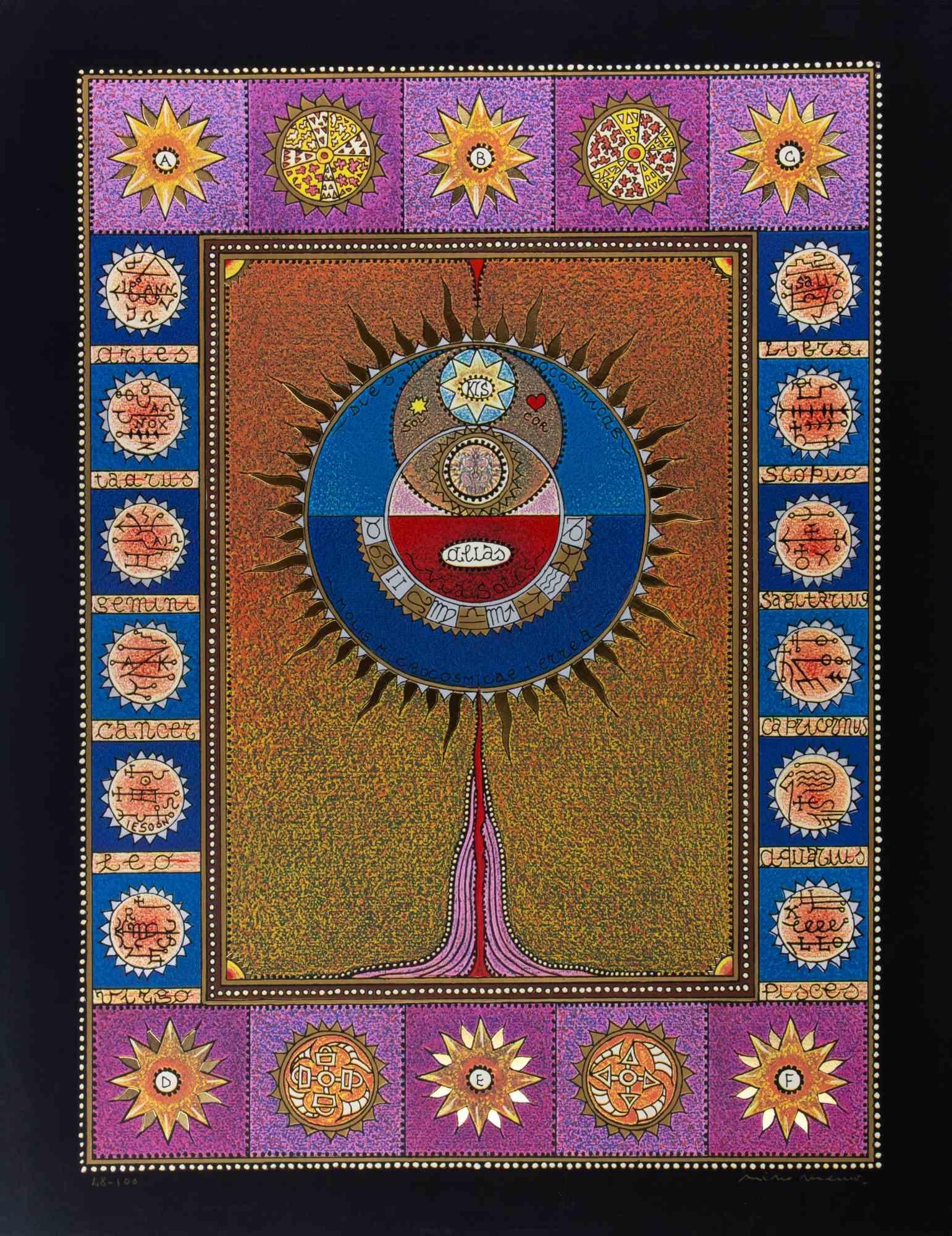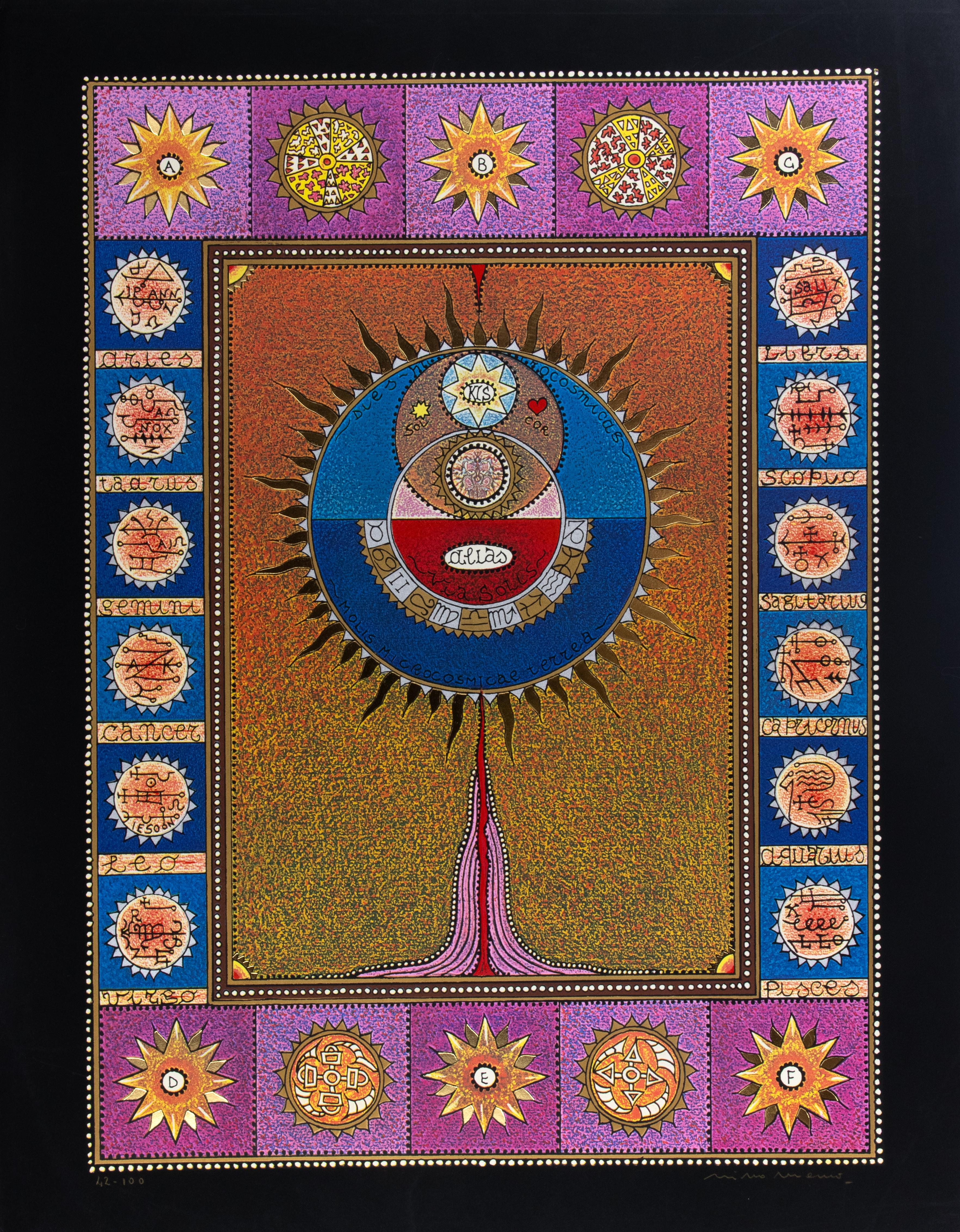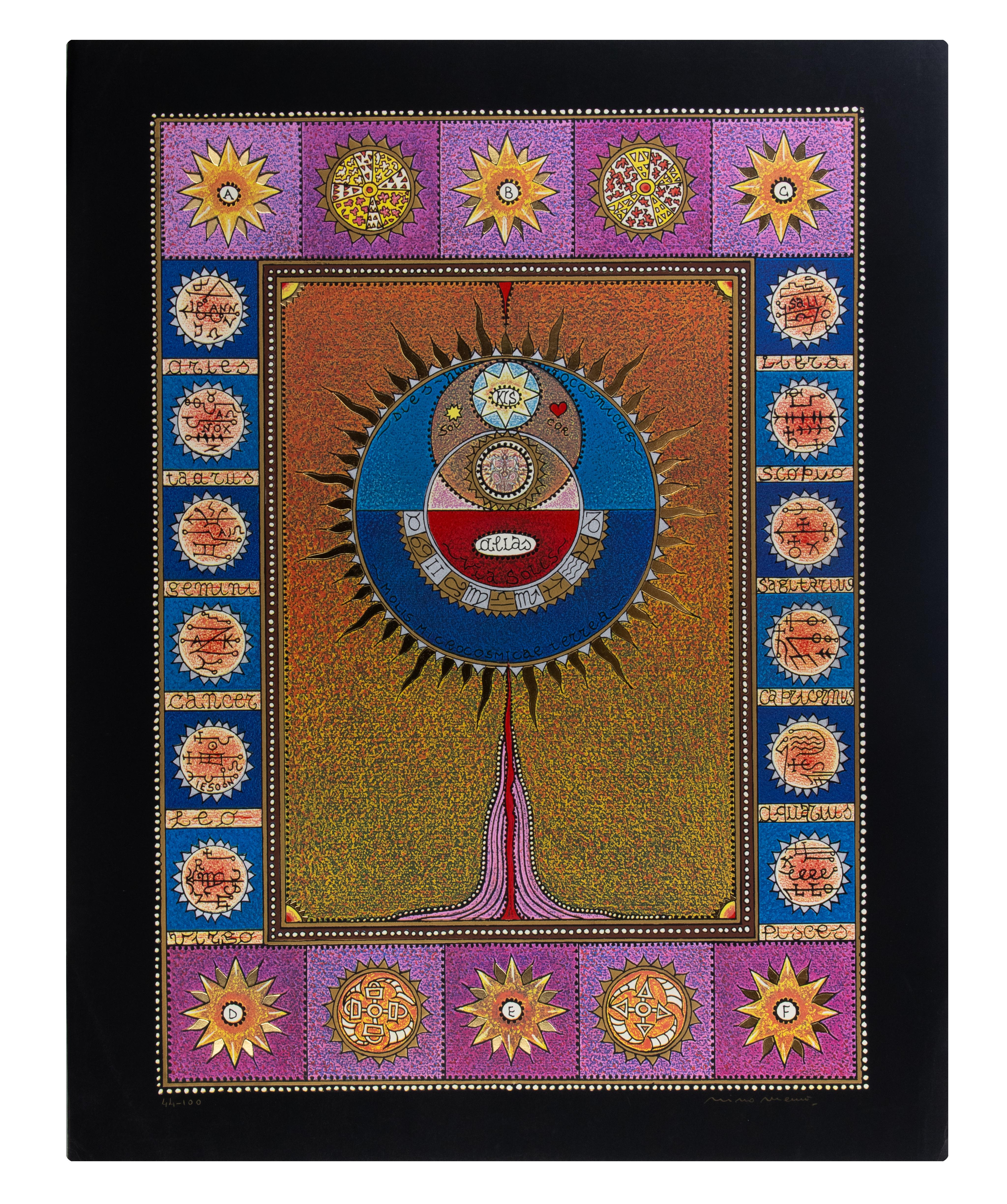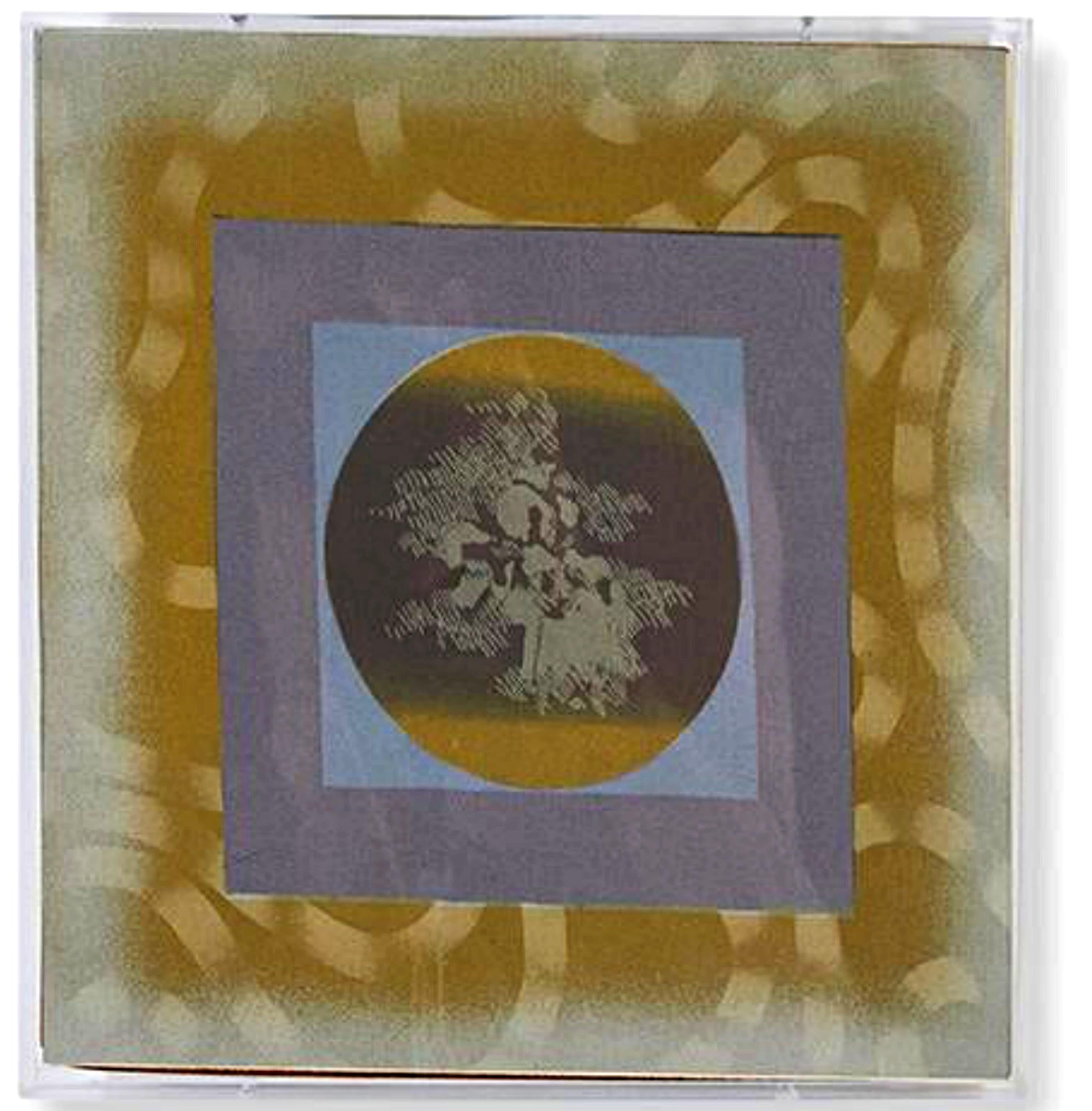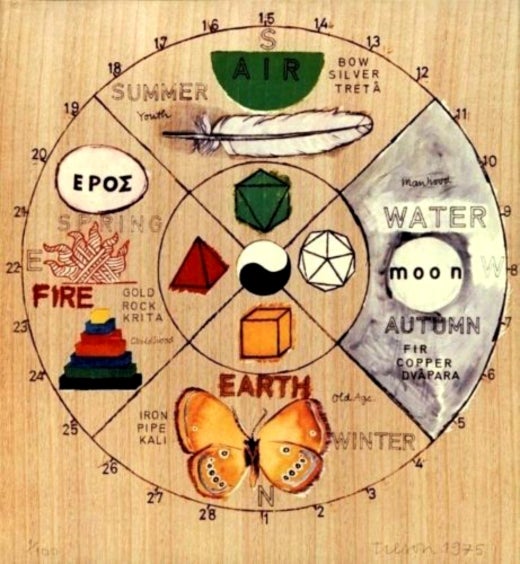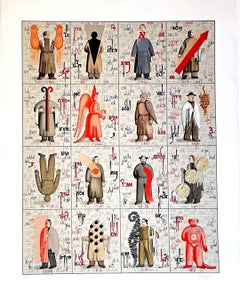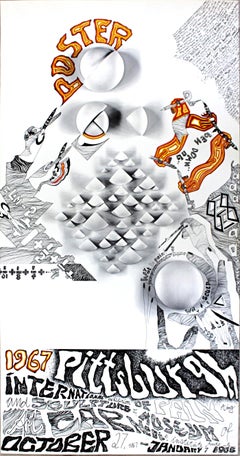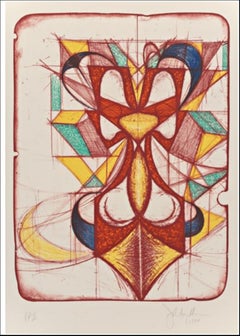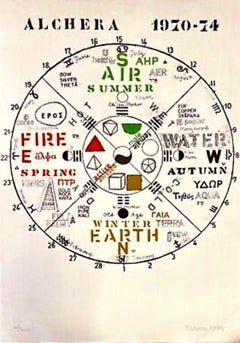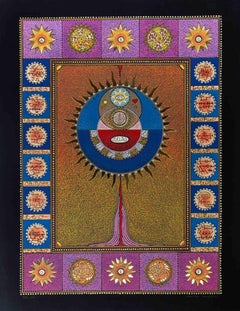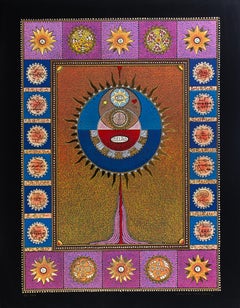Items Similar to Mnemonic Device, Silkscreen with hand coloring, Signed/N British Pop Art pioneer
Want more images or videos?
Request additional images or videos from the seller
1 of 6
Joe TilsonMnemonic Device, Silkscreen with hand coloring, Signed/N British Pop Art pioneer1975
1975
$2,800
£2,169.75
€2,462.22
CA$4,013.12
A$4,407.20
CHF 2,268.66
MX$52,733.43
NOK 28,885.01
SEK 27,069.56
DKK 18,388.88
About the Item
Joe Tilson
Mnemonic Device, 1975
Silkscreen with hand coloring on Thin Bamboo Wood Sheet
21 1/4 × 19 1/2 inches
Edition 96/100
Hand signed and numbered from an edition of 100 on recto
Unframed
This impressive 1975 silkscreen with hand coloring on thin bamboo wood sheet is pencil signed and numbered from the limited edition of 100. It is based on an original acrylic on board work by important British Pop Artist Joe Tilson that is in the permanent collection of the Marconi Foundation in Italy
- Creator:Joe Tilson (1928, British)
- Creation Year:1975
- Dimensions:Height: 21.25 in (53.98 cm)Width: 19.5 in (49.53 cm)
- Medium:
- Movement & Style:
- Period:
- Condition:
- Gallery Location:New York, NY
- Reference Number:1stDibs: LU1745210817702
Joe Tilson
Joe Tilson (1928 – Present) Tilson was born on 24th August, 1928 in London, England. Tilson served in the Royal Air Force from 1946 – 49, after which he studied at St Martin’s School of Art (1949-1952) and the Royal College of Art (1952 – 1955). He won the Rome Prize for graduation, taking him to Italy from 1955 - 1957. From 1958 – 1963, Tilson taught at St Martin’s School of Art, the Slade School of Fine Art, University College London and the School of Visual Arts, New York. During the 1960s, Tilson’s artistic career took off as he attracted attention for his unique wooden reliefs and constructions, prints and paintings in the emerging British Pop Art style. He held his first solo exhibition at the Marlborough Galley, London in 1962. In 1977, Tilson joined the Waddington Galleries, exhibited at the Alan Cristea Gallery and the Giò Marconi Galleries in Milan. At the Venice Biennale in 1964, Tilson’s work began to gain international popularity, earning him a retrospective at the Boyman’s Museum, Rotterdam later that year. Growing anti-consumerist feeling in the 1970s pushed Tilson to begin to incorporate a wider variety of materials in his work, including stone, straw and rope to create a timeless feel to his work. This body of work was called Alchera, and was a huge success. Tilson was made a Royal Academician in 2002 which was celebrated with a retrospective exhibition in the same year at the Royal Academy entitled Joe Tilson: Pop to Present. Tilson is collected internationally, including at the Arts Council England, London; the British Library, London; Christchurch College, Oxford; the Ludwig Múzeum, Budapest; the Tate, London; Royal Academy of Arts, London; Scottish National Gallery of Modern Art, Edinburgh; The Royal Collection; Victoria and Albert Museum, London; Museum of Modern Art (MoMA), New York and the Yale Centre for British Art, New Haven
About the Seller
5.0
Platinum Seller
Premium sellers with a 4.7+ rating and 24-hour response times
Established in 2007
1stDibs seller since 2022
461 sales on 1stDibs
Typical response time: 2 hours
- ShippingRetrieving quote...Shipping from: New York, NY
- Return Policy
More From This Seller
View AllCalifornia Cool Pop Art Mixed media & lithograph hand signed 20/20, artist label
By Billy Al Bengston
Located in New York, NY
Billy Al Bengston
Cockatoo AAA Dracula, 1968
Lithograph , Zinc and Aluminum, in Silver-Violet, Yellow, Two Grays and Orange on uncalendered Rives paper
Frame included
signed faintly ...
Category
1960s Pop Art Abstract Prints
Materials
Mixed Media, Lithograph
Note D, silkscreen by renowned Russian-American Jewish dissident artist Signed/N
By Grisha Bruskin
Located in New York, NY
Grisha Bruskin
Note D, 1991
Color silkscreen on Somerset paper
34 × 27 inches
Edition 74/75
Boldly signed and numbered on front in graphite pencil.
Published by Marlborough Graphics ...
Category
1980s Modern Abstract Prints
Materials
Screen
Rare historic 1960s Lt Ed Fluxus poster Pittsburgh International Carnegie Museum
By Mary Bauermeister
Located in New York, NY
Mary Bauermeister
Pittsburgh International Carnegie Museum, 1967
Offset Lithograph Poster
20 × 37 inches
Edition of 500
Unframed
This is the original, historic poster designed by Mar...
Category
1960s Abstract Abstract Prints
Materials
Offset, Lithograph
Color Double, signed & annotated geometric abstraction sculptural lithograph PP2
By John Newman
Located in New York, NY
John Newman (b.1952)
Color Double, 1990
Color Lithograph
Signed, annotated, and dated in graphite pencil on the front. Edition of 2 (PP II, aside from the regular edition of 32)
27 × 19 3/4 inches
Unframed
Accompanied by gallery issued Certificate of Guarantee
A rare signed Printers Proof, aside from the regular edition of only 32
John Newman received his Masters of Fine Arts degree from the Yale School of Art...
Category
1990s Abstract Geometric Abstract Prints
Materials
Lithograph
Richard Pettibone The Appropriation Warhol, Stella, Lichtenstein, Unique Signed
By Richard Pettibone
Located in New York, NY
Richard Pettibone
The Appropriation Print Andy Warhol, Frank Stella, Roy Lichtenstein, 1970
Silkscreen in colors on masonite board (unique variant on sculpted board)
Hand-signed by artist, Signed and dated on the front (see close up image)
Bespoke frame Included
This example of Pettibone's iconic Appropriation Print is silkscreened on masonite board rather than paper, giving it a different background hue, and enabling it work to be framed so uniquely.
The Appropriation print is one of the most coveted prints Pettibone ever created ; the regular edition is on a full sheet with white background; the present example was silkscreened on board, allowing it to be framed in 3-D. While we do not know how many examples of this graphic work Pettibone created, so far the present work is the only one example we have ever seen on the public market since 1970. (Other editions of The Appropriation Print have been printed on vellum, wove paper and pink and yellow paper.)
This 1970 homage to Andy Warhol, Frank Stella and Roy Lichtenstein exemplifies the type of artistic appropriation he was engaging in early on during the height of the Pop Art movement - long before more contemporary artists like Deborah Kass, Louise Lawler, etc. followed suit.
This silkscreen was in its original 1970 vintage period frame; a bespoke custom hand cut black wood outer frame was subsequently created especially to house the work, giving it a distinctive sculptural aesthetic.
Measurements:
Framed 14.5 inches vertical by 18 inches horizontal by 2 inches
Work
13 inches vertical by 16.5 inches horizontal
Richard Pettibone biography:
Richard Pettibone (American, b.1938) is one of the pioneering artists to use appropriation techniques. Pettibone was born in Los Angeles, and first worked with shadow boxes and assemblages, illustrating his interest in craft, construction, and working in miniature scales. In 1964, he created the first of his appropriated pieces, two tiny painted “replicas” of the iconic Campbell’s soup cans by Andy Warhol (American, 1928–1987). By 1965, he had created several “replicas” of paintings by American artists, such as Warhol, Roy Lichtenstein (1923–1997), Ed Ruscha (b.1937), and others, among them some of the biggest names in Pop Art. Pettibone chose to recreate the work of leading avant-garde artists whose careers were often centered on themes of replication themselves, further lending irony to his work. Pettibone also created both miniature and life-sized sculptural works, including an exact copy of Bicycle Wheel by Marcel Duchamp (French, 1887–1968), and in the 1980s, an entire series of sculptures of varying sizes replicating the most famous works of Constantin Brancusi (Romanian, 1876–1957). In more recent years, Pettibone has created paintings based on the covers of poetry books by Ezra Pound, as well as sculptures drawn from the grid compositions of Piet Mondrian (Dutch, 1872–1944). Pettibone straddles the lines of appropriation, Pop, and Conceptual Art, and has received critical attention for decades for the important questions his work raises about authorship, craftsmanship, and the original in art. His work has been exhibited at the Institute for Contemporary Art in Philadelphia, the Museum of Modern Art in New York, the Museum of Contemporary Art in Miami, and the Laguna Art Museum in Laguna Beach, CA. Pettibone is currently based in New York.
"I wished I had stuck with the idea of just painting the same
painting like the soup can and never painting another painting.
When someone wanted one, you would just do another one.
Does anybody do that now?"
Andy Warhol, 1981
Since the mid-1960s, Richard Pettibone has been making
hand-painted, small-scale copies of works by other artists — a
practice due to which he is best known as a precursor of appropriation art — and for a decade now, he has been revisiting subjects from across his career. In his latest exhibitions at
Castelli Gallery, Pettibone has been showing more of the “same”
paintings that had already been part of his 2005–6 museum retrospective,1
and also including “new” subject matter drawn from
his usual roster of European modernists and American postwar
artists. Art critic Kim Levin laid out some phases of the intricate spectrum from copies to repetitions in her review of the
Warhol-de Chirico showdown, a joint exhibition at the heyday
of appropriation art in the mid-1980s when Warhol’s appropriations of de Chirico’s work effectively revaluated “the grand
old auto-appropriator”.
Upon having counted well over a dozen
Disquieting Muses by de Chirico, Levin speculated: “Maybe he
kept doing them because no one got the point. Maybe he needed the money. Maybe he meant it when he said his technique
had improved, and traditional skills were what mattered.”
On
the other side, Warhol, in her eyes, was the “latter-day exemplar
of museless creativity”.
To Pettibone, traditional skills certainly
still matter, as he practices his contemporary version of museless creativity. He paints the same painting again and again,
no matter whether anybody shows an interest in it or not. His
work, of course, takes place well outside the historical framework of what Levin aptly referred to as the “modern/postmodern wrestling match”,
but neither was this exactly his match
to begin with.
Pettibone is one of appropriation art’s trailblazers, but his diverse
selection of sources removes from his work the critique of the
modernist myth of originality most commonly associated with
appropriation art in a narrow sense, as we see, for example, in
Sherrie Levine’s practice of re-photographing the work of Walker
Evans and Edward Weston. In particular, during his photorealist
phase of the 1970s, Pettibone’s sources ranged widely across
several art-historical periods. His appropriations of the 1980s
and 1990s spanned from Picasso etchings and Brancusi sculptures to Shaker furniture and even included Ezra Pound’s poetry.
Pettibone has professed outright admiration for his source artists, whose work he shrinks and tweaks to comic effect but, nevertheless, always treats with reverence and care. His response
to these artists is primarily on an aesthetic level, owing much
to the fact that his process relies on photographs. By the same
token, the aesthetic that attracts him is a graphic one that lends
itself to reproduction. Painstakingly copying other artists’ work by hand has been a way of making
it his own, yet each source is acknowledged in
his titles and, occasionally, in captions on white
margins that he leaves around the image as an
indication that the actual source is a photographic image. The enjoyment he receives in copying
is part of the motivation behind doing it, as is
the pleasure he receives from actually being with
the finished painting — a considerable private
dimension of his work. His copies are “handmade
readymades” that he meticulously paints in great quantities in his studio upstate in New York; the commitment
to manual labor and the time spent at material production has
become an increasingly important dimension of his recent work.
Pettibone operates at some remove from the contemporary art
scene, not only by staying put geographically, but also by refusing to recoup the simulated lack of originality through the
creation of a public persona.
In so doing, Pettibone takes a real
risk. He places himself in opposition to conceptualism, and he is
apprehensive of an understanding of art as the mere illustration
of an idea. His reading of Marcel Duchamp’s works as beautiful
is revealing about Pettibone’s priorities in this respect.
When
Pettibone, for aesthetic pleasure, paints Duchamp’s Poster for
the Third French Chess...
Category
1970s Pop Art Abstract Prints
Materials
Masonite, Pencil, Screen
Rainbow Signed/N 1970s silkscreen & lithograph, pioneering female Fluxus artist
By Mary Bauermeister
Located in New York, NY
Mary Bauermeister
Rainbow, 1973
Lithograph and silkscreen on creamy white paper
Hand signed, dated and numbered 56/250 by the artist on the front
19 x 25.5 inches
Unframed
This work is on the permanent collection of various institutions like: Rice University, Samuel Dorksy Museum of Art, Rutgers Zimmerli Museum and Wheaton College Massachusetts.
While studying the fringe sciences the 1970s, Bauermeister created Rainbow (1973), a lithograph and silkscreen. She uses a creamy white background as the base. Two intersecting diagonal bands of color transcend across the page, and black cursive lettering dances over the surface serving as a mind map of interweaving ideas. Through the central band, Bauermeister shifts through the color spectrum; she begins with red and finishes with violet. Inspired by music, she uses strokes of color that are rhythmically smeared across the lithograph.
The surface lettering, a kind of visual poetry, explores her interest in human emotion and science. The viewer can see Bauermeister’s thoughts as they flow into one another through the use of words such as bliss, love, and healing. Bauermeister also includes a repetition of words such as cancer, sickness, and cure. The word cancer emerges from a cell-like shape. A careful study of the words shows that they may seem dark in nature; however, she juxtaposes these words against the cheerful title and colors. Perhaps the rainbow symbolizes a new hope, an inspiration for an optimistic future.
-Courtesy to the Samuel Dorsky Museum of Art
About Mary Bauermeister:
A multidisciplinary artist known for her intricate and enigmatic assemblages, Mary Bauermeister (1934-2023) continues to defy categorization with layered works in a range of media. A precursory figure of the Fluxus movement—her studio was the meeting point for a number of defining artists of the avant-garde—her work plays an integral role in the discussion of art, both European and American, that emerged from the 1960s. Her reliefs and sculptures, which have incorporated drawing, text, found objects, natural materials and fabric, reference a plethora of concepts: from natural phenomena and astronomy to mathematics and language, as well as her own “spiritual-metaphysical experiences.” Maturing amidst the currents of Minimalism and Pop Art, Bauermeister’s art has resisted labels due to the singular expression of her interests and concerns, among them the simultaneous transience and permanence of the natural world with experimentations in transparency and magnification, multiplication and variation, structure and order, chance and ephemerality, introversion and extroversion. Her three-dimensional receptacles of thoughts, ideas, and notes contain visual, conceptual, and philosophical paradoxes that challenge perceptions and that offer literal and metaphorical windows into which one can glimpse the inner workings of the artist’s mind.
- Courtesy of Michael Rosenfeld...
Category
1970s Abstract Abstract Prints
Materials
Lithograph, Screen, Mixed Media
You May Also Like
Joe Tilson British Pop Art Screenprint, Color Lithograph 4 Seasons 4 Elements
By Joe Tilson
Located in Surfside, FL
Silkscreen screenprint or Lithograph
Hand signed and numbered. An esoteric, mystical, Kabbala inspired print with Hebrew as well as other languages.
Joseph Charles Tilson RA (born 2...
Category
1970s Pop Art Abstract Prints
Materials
Screen, Lithograph
Esoteric Composition - Screenprint by Mino Meno - 1980s
Located in Roma, IT
Screen print realized by Mino Meno in 1980s.
Hand signed lower right. Numbered lower left.
Edition of 100.
Excellent condition.
Category
1980s Contemporary Abstract Prints
Materials
Screen
Esoteric Composition - Screen Print by Mino Meno - 1970s
Located in Roma, IT
Screen print realized by Mino Meno in 1980s.
Hand signed lower right. Numbered lower left.
Edition of 100.
Excellent condition.
Category
1980s Contemporary Abstract Prints
Materials
Screen
$248 Sale Price
30% Off
Esoteric Composition - Screen Print by Mino Meno - 1970s
Located in Roma, IT
Screen print realized by Mino Meno in 1980s.
Hand signed lower right. Numbered lower left.
Edition of 100.
Excellent condition.
Category
1980s Contemporary Abstract Prints
Materials
Screen
Tantra Abstractions, Abstract Pop Art Screenprint by John Grillo
By John Grillo
Located in Long Island City, NY
Artist: John Grillo, American (1917 - 2014)
Title: Tantra Abstractions
Year: 1980
Medium: Screenprint, signed and numbered in pencil
Edition: 200, AP 30
Image Size: 30 x 22 inch...
Category
1980s Pop Art Abstract Prints
Materials
Screen
The Arrow of Metals - Screenprint by Mino Meno - 1980s
Located in Roma, IT
Screen print on cardboard realized by Mino Meno in 1980s.
Artist's Proof, hand signed.
Excellent condition.
Category
1980s Contemporary Abstract Prints
Materials
Screen
More Ways To Browse
Kandinsky Original
Karl Alexander
Mark Mothersbaugh
P Morgan Art
Pop Art Rolling Stones
Tamarind Prints
Vintage Dairy Products
Cesar Domela
El Ultimo
Ernest Trova Falling Man
Frank Stella Signed Lithographs
Joan Miro Litografia
Miro Galerie Maeght
Red And Black Poster
Vintage 10X10 Frame
A R Penck
Antoni Miro
Chryssa Chinatown
